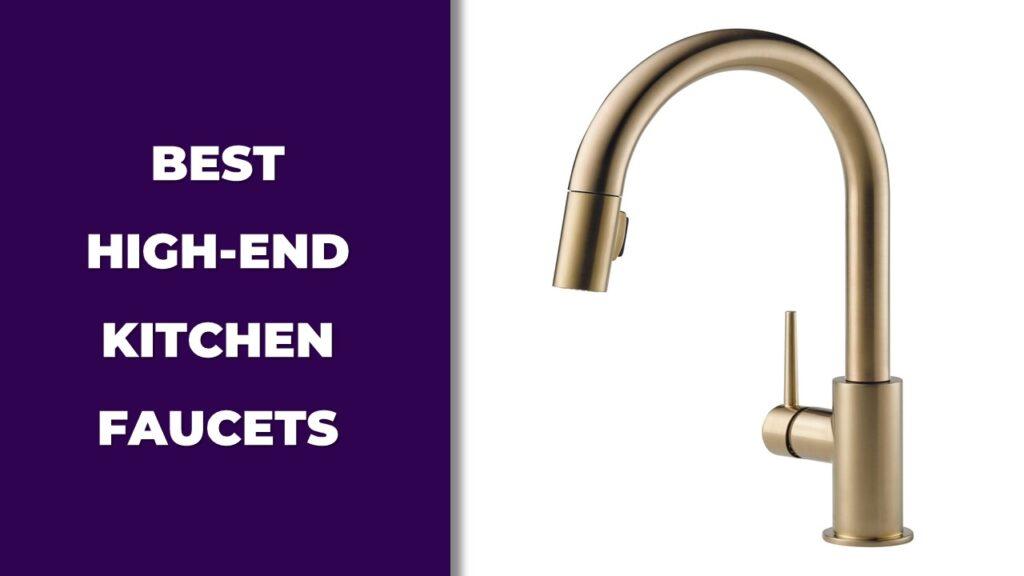
The difference between a 4 inch and 8 inch faucet is the spacing between the handles. A 4 inch faucet, often called a centerset faucet, combines the spout and handles on one base. An 8 inch faucet, usually a widespread type, has separate handles and fits larger sink areas.
In this article, we’ll compare 4 inch and 8 inch faucets by size, design, installation needs, and where each one works best.
What Is a 4 Inch Faucet?
A 4 inch faucet is like the go-to option for small sinks. It’s built for sinks with three holes that are spaced just 4 inches apart. Everything—handles and spout—sits close together on one compact base, which makes it perfect if you’re working with limited space. You’ll often see these in bathrooms or powder rooms because they’re practical and don’t take up much room. If you’re after something that’s easy to install, affordable, and just gets the job done without fuss, a 4 inch faucet might be what you need.
What Is an 8 Inch Faucet?
An 8 inch faucet is a bit more spread out—literally. It’s designed for sinks with three holes spaced 8 inches apart, and the handles and spout are all separate. This gives it a more elegant and spacious vibe, which is why it’s a popular choice for larger sinks, especially in kitchens or big bathrooms. The setup feels a bit fancier and offers more flexibility in terms of design. That said, it does need more space and can take a little extra effort to install, but the result is definitely worth it if you want your sink to stand out. An 8-inch faucet can be a perfect choice for your kitchen sink, especially if you’re dealing with specific water conditions—check out our guide on the kitchen faucets for hard water for more insights and options.
What Are the Main Differences Between 4 Inch and 8 Inch Faucet?
When choosing between a 4 inch and 8 inch faucet, understanding their differences is key to making the right decision. Here’s how they stack up in terms of size, installation, design, and cost.
Comparison Table: 4 Inch vs. 8 Inch Faucets
| Feature | 4 Inch Faucet | 8 Inch Faucet |
| Size and Spacing | Compact design; handles and spout close together. Ideal for small sinks and bathrooms. | Widespread design; handles and spout are separate. Perfect for larger sinks and countertops. |
| Installation | Easier and quicker to install. Great for DIY projects. | Requires more precise alignment; might need professional installation. |
| Design Options | Minimalist and practical. Limited in style variety. | Offers a wide range of elegant and customizable designs. |
| Cost | Budget-friendly; affordable materials and simpler designs. | Higher cost due to larger size, intricate designs, and premium finishes. |
| Best For | Small sinks, compact bathrooms, or tight spaces. | Larger sinks, kitchens, or spaces with luxury decor. |
Size and Spacing
The most obvious difference is the spacing between the handles and spout. A 4 inch faucet has everything tightly grouped together on a single base, which is ideal for smaller sinks and compact areas like bathrooms. On the other hand, an 8 inch faucet has its components spread out, offering a more spacious, open look. This makes it a better fit for larger sinks or countertops, where a wider layout enhances visual appeal. If your sink area feels cramped, a 4 inch faucet can save space, while an 8 inch faucet adds an air of luxury to roomier setups.
Installation Process
If you’re all about quick and easy, the 4 inch faucet wins here. Its compact design is simple to install, even for those who prefer a DIY approach. For an 8 inch faucet, the installation is a bit more involved since the components are separate and require precise alignment. However, the payoff is a fully customized look that can elevate the overall feel of your sink. While 4 inch faucets are plug-and-play, 8 inch faucets offer more room for creativity but might need a bit of extra effort or professional help.
Design and Style Options
When it comes to design, 4 inch faucets lean toward simplicity and practicality. They often come in minimalist styles that blend seamlessly into smaller spaces. In contrast, 8 inch faucets are all about making a statement. They offer a wide range of elegant designs and finishes, from brushed nickel to matte black, giving you more options to match your decor. If you’re after functionality without frills, a 4 inch faucet is your best bet. But if style and customization matter more, the 8 inch faucet is hard to beat.
Cost Comparison
4 inch faucets are usually the more budget-friendly choice. Their straightforward design and smaller size make them more affordable, both upfront and in terms of installation costs. Meanwhile, 8 inch faucets often come with a higher price tag due to their larger size and more intricate designs. The cost can also depend on materials, finishes, and extra features like pull-out sprayers or touchless controls. If you’re working on a tight budget, a 4 inch faucet offers great value. But if you’re ready to splurge, the 8 inch faucet delivers a high-end look and feel. If you’re curious about how different faucet features impact functionality, you might also find our explanation of what a metering cycle in a faucet is quite insightful.
What Are the Advantages of 4 Inch Faucets?
4 inch faucets are all about practicality and ease of use. Their compact size makes them an ideal choice for small spaces, like bathroom sinks or powder rooms, without compromising on functionality. Plus, they’re often more affordable and easier to install, which is a big win for many homeowners.
- Compact design fits perfectly in smaller sinks and tight spaces.
- Affordable pricing makes them a budget-friendly option.
- Easy installation, great for DIY projects.
- Widely available in a variety of simple designs and finishes.
- Ideal for bathrooms or sinks with limited countertop space.
What Are the Disadvantages of 4 Inch Faucets?
While 4 inch faucets are practical, they come with a few limitations. Their smaller size can restrict design variety, and they might not provide the reach or presence needed for larger sinks or spaces. If you’re looking for something elegant or spacious, these might feel a bit underwhelming.
- Limited design options compared to larger faucets.
- Less suited for large sinks or countertops.
- Compact spacing may feel crowded when handling.
- Lower water flow in some models due to the smaller size.
What Are the Advantages of 8 Inch Faucets?
An 8 inch faucet is all about making a statement. Its widespread design adds elegance and flexibility, perfect for larger sinks and countertops. These faucets are great if you’re looking for a luxurious upgrade or want more freedom in choosing a unique style.
- Spacious layout provides a more luxurious and elegant look.
- Great for larger sinks and countertops, creating balance in big spaces.
- Offers more design variety, including premium and high-end finishes.
- Provides better water flow and reach in most models.
- Ideal for kitchens and upscale bathrooms.
What Are the Disadvantages of 8 Inch Faucets?
Despite their upscale appeal, 8 inch faucets have a few downsides. They require more countertop space, are pricier, and often take longer to install. If space or budget is a concern, this may not be the best choice.
- Higher cost compared to 4 inch faucets.
- Installation is more complex and may require professional help.
- Requires larger sink space, which may not fit in compact areas.
- Not as practical for those on a tight budget or with limited space.
Installation and Maintenance Tips for 4 Inch and 8 Inch Faucets
Whether you’re installing a new faucet or maintaining an existing one, a little preparation and care can go a long way. With the right tools and some attention to detail, you can ensure a smooth installation and keep your faucet looking and working like new. Here’s everything you need to know.
Tools and Materials Needed
Having the right tools can make your installation quick and hassle-free. These essentials will help you get the job done right the first time.
- Adjustable wrench
- Plumber’s tape (Teflon tape)
- Basin wrench
- Bucket or towel (to catch any water)
- Silicone sealant (optional, for securing the base)
- Screwdriver
Step-by-Step Guide for Each 4 Inch and 8 Inch Faucet Type
Proper installation is the key to a leak-free and efficient faucet. Follow these steps to install your 4 inch or 8 inch faucet like a pro.
4-Inch Faucet Installation
- Turn off the water supply: Shut off the valves under the sink and release any leftover water by turning on the faucet.
- Remove the old faucet: Use a basin wrench to loosen the mounting nuts and disconnect the water supply lines.
- Place the new faucet: Align the 4 inch faucet with the sink’s pre-drilled holes. Use silicone sealant around the base for extra stability (optional).
- Secure the faucet: Tighten the mounting nuts underneath the sink using your wrench.
- Attach the water lines: Connect the hot and cold water lines to the corresponding inlets.
- Turn on the water supply: Check for leaks and ensure the faucet operates smoothly.
8-Inch Faucet Installation
Installing an 8 inch faucet requires a bit more precision due to the wider spacing, but it’s still manageable with the right approach.
- Turn off the water supply: Shut off the valves and drain the lines.
- Remove the old faucet: Detach the existing faucet and clean the sink area.
- Align the components: Place the spout and handles into the sink’s pre-drilled holes. Ensure proper alignment with the 8 inch spacing.
- Secure each piece: Use a wrench to tighten the mounting nuts for the spout and handles individually.
- Connect water supply lines: Attach the hot and cold water lines to the corresponding handles.
- Turn on the water supply: Test for leaks and adjust fittings if necessary.
Common Mistakes to Avoid During Installation
Even small errors during installation can lead to annoying leaks or misalignments. Watch out for these common mistakes to save yourself extra hassle later.
- Skipping the plumber’s tape: This can lead to leaks at connection points.
- Over-tightening: Excessive force can damage the faucet or strip the threads.
- Mismatched water lines: Always connect hot and cold lines correctly to avoid confusion.
- Ignoring sink size: Ensure the faucet size matches the sink holes and countertop space.
Maintenance Guidelines
Once your faucet is installed, keeping it in good condition is just as important. Regular maintenance ensures it looks great and works efficiently for years.
- Regular Cleaning: Wipe the faucet with a damp cloth to remove water spots and soap residue. Use a mild cleaner for tougher stains.
- Prevent Mineral Build-Up: Clean the aerator periodically by unscrewing it and soaking it in vinegar to remove lime deposits.
- Check for Leaks: Inspect connections and seals periodically to catch small leaks before they cause bigger problems.
- Protect the Finish: Avoid abrasive cleaners or scrubbers that can scratch or dull the finish.
- Lubricate Moving Parts: For faucets with handles, apply a small amount of silicone grease to keep them turning smoothly.
With the right tools, careful installation, and regular maintenance, your 4 inch or 8 inch faucet will continue to work like a charm, adding style and function to your space.
Wrapping It Up!
Choosing between a 4 Inch vs 8 Inch Faucet comes down to your sink size, style preferences, and budget. A 4 inch faucet is perfect for smaller sinks and simpler setups, offering practicality and affordability. On the other hand, an 8 inch faucet adds elegance and functionality to larger sinks, especially in more luxurious spaces.
By considering factors like countertop space, room design, and functionality, you can confidently pick the faucet that works best for your needs. Whether you prefer the compact convenience of a 4 inch faucet or the statement look of an 8 inch one, the right choice will enhance your space and make daily tasks more enjoyable.
Related FAQs
Can I switch from a 4-inch faucet to an 8-inch faucet?
Yes, but it depends on your sink. If your sink has pre-drilled holes for a 4 inch faucet, you’ll need to replace it with a sink compatible with 8 inch spacing or drill new holes, which can be tricky.
Which faucet type is better for water flow?
Neither size directly impacts water flow. It depends on the faucet design, aerator, and water pressure in your home. Some 8 inch faucets may offer better reach, but the flow is usually comparable.
Are 8-inch faucets worth the extra cost?
They can be if you value their elegant design and added functionality. An 8 inch faucet is great for larger sinks and adds a more premium feel, but it’s not necessary for every space.
Do I need a professional to install a faucet?
Not always. A 4 inch faucet is easy to install, even for beginners. For 8 inch faucets, the wider spacing might require more precision, so hiring a professional can save time and avoid mistakes.
What’s the most common mistake when installing a faucet?
One common mistake is skipping plumber’s tape, which can cause leaks at the connections. Another is over-tightening, which can damage the faucet or strip the threads.
How do I maintain my faucet to keep it looking new?
Clean your faucet regularly with a damp cloth to remove water spots and avoid abrasive cleaners that can scratch the finish. For mineral build-up, soak the aerator in vinegar and rinse thoroughly.

Dylan Foster is a family man with years of hands-on experience in plumbing, household maintenance, and fixing everyday issues around the home. A former plumber, Dylan knows what it’s like to deal with tricky leaks, worn-out parts, and all the little problems that pop up in a house. From plumbing repairs to kitchen fixes and garden hose setups, he’s done it all. Dylan shares real-world solutions to help others keep their homes running smoothly and avoid costly mistakes.




